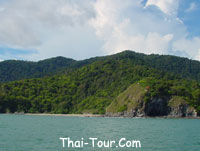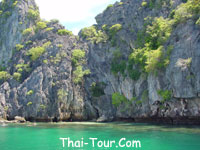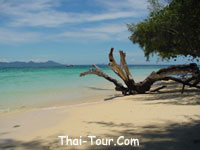Koh Lanta
Ko Lanta lies on the west coast of Andaman Sea in between Krabi and Phi Phi Island. Large Size Island with 6 km wide and over 30 kms long, 9 beaches lie from north to south along the sunset coast. Stunning scenery, fantastic white sandy beaches, coastlines have more than 70 small islands and plenty with forest, coral reefs and under water life. Koh Lanta consists of 52 islands that from the Southernmost district of Krabi province. The two largest islands are Koh Lanta Yai and Koh Lanta Noi. The other islands are many different-sized island, some of which are surrounded by beautiful coral reefs such as Koh Ha, Koh Rok and Koh Hai (or Koh Ngai). The main island in the park is Ko Lanta Yai, where both the District Headquarters and National Park Office are located. The island itself is generally rugged and mountainous. There are beaches both gravelly and sandy toward the south. The suitable time to visit Ko Lanta is from November to April.
|
|
The best beaches are along the north and south of the Koh Lanta Yai's west coast. Ban Saladan is a village which now becomes the most popular center of visitors. Ferry pier, markets, banks, shops are found here. The development is slowly progressing. I found a concrete road to Kantain Bay (almost the southernmost bay of the island). It has not yet been ready for an explorer like me to get to the national park which is located at the end of the island (the southernmost part). I was told by the park officer, the government has plan to build a road connecting the west and east part along the island soon.
| Ko Lanta is also home to "Chao Le" or sea gypsies. They still maintain their old way of life and have peculiar traditions, such as setting a boat adrift to drive out evil and bring good luck. This is done during the full moon in June and in November. |
Koh Lanta has emerged strong despite the horrendous results of the Tsunami in Dec 04. Unlike other islands, Koh Lanta made it through relatively scathed. Recovery and rebuilding has taken place to a point that the island is back to its routine of playing the most exemplary of hosts to its visitors.
Koh Lanta was very lucky in that no big damage occurred to the natural scenic beauty. All the beaches remain as beautiful as ever. All dive sites did not suffer in the disaster, rather the water is cleaner and clearer than ever.
Now back in full tourism mode, I saw visitors are returning when I last visited in Apr 06. Some stay for weeks or months at a time. People say Koh Lanta's charms are found not only in the azure bounty of its divers islands but also in the friendly hospitality of its people.
Climate:
The average temperature is 27-33 degrees Celsius or 81-91 Farenheit year-round. From May to October, the monsoon occasionally brings heavy rains, but days are sunny and the rain starts and stop alternatively. From November to April, the humidity is low, and the breeze can be quite cool in the evening. These periods are commonly called 'green-season' and 'high-season' respectively.
Population:
People here is about 20,000, the majority of which are Muslims. The Sea Gypsies (Chao Lay in Thai) and Thai-Chinese people also blend into the total population living on Koh Lanta. Despite their difference, the three groups have managed to live happily together for several centuries. The steadily increasing population other than Muslims come from other parts of the country because of the development of tourism. During the high-season, we say that tourists are more visible than the local residents.
Most people live in Koh Lanta Noi which is Kon Lanta's administrative center and Koh Lanta Yai has recently become a melting pot of people of all cultures. The Sea Gypsies are still making a living fishing. Some others take care of their rubber or coconut plantations. Seasonal residents are foreigners, mostly Europeans who spend six months of the year in Koh Lanta running small businesses such as bar and restaurants.
Local Products:
OTOP (One Tambol, One Product) of Koh Lanta as supported by the government are batik textiles, wooden furnitures, local coffee, herbs, crab cakes, shrimp crackers and handicrafts made from toey panan (pandanus tectorium soland), a local pant. In the fresh food department, there is hoi chak teen i.e. a winged shell which looks similar to walking legs, referred as "feet" or 'teen' (informal Thai). Hoi Chak Teen is eaten with a Thai seafood sauce which is an essential dip made with fish sauce, garlic, chilies, lime juice and sugar.
Financial Matters:
Nowadays, there are ATM machines all over the island. Bank office can be found at Saladan village. Bank operate daily Monday to Friday from 8:30 - 15:30 hrs. There is also a Western Union.
................................................................




